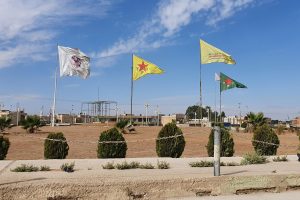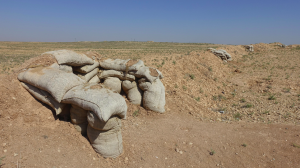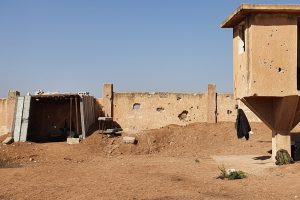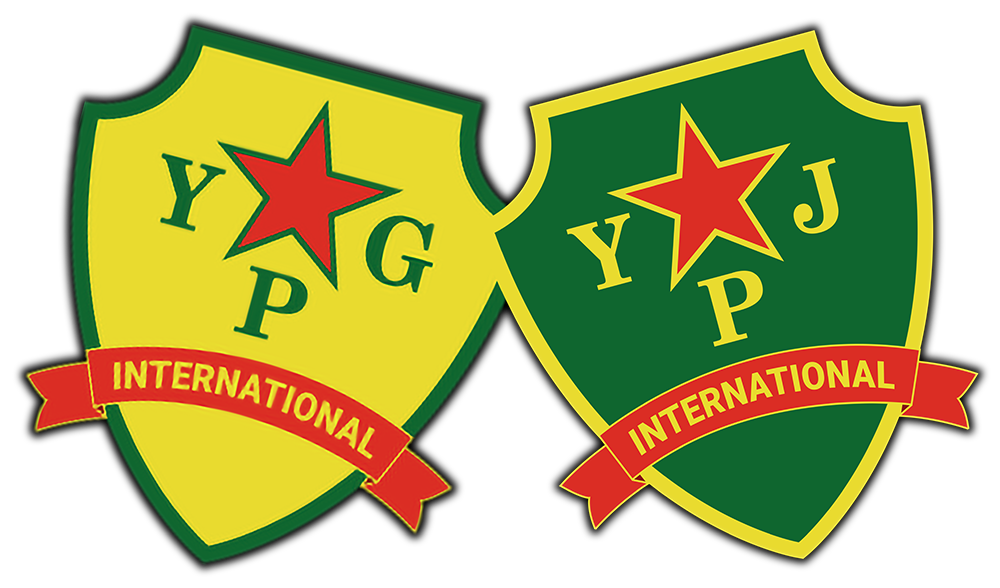YPG-International: A report from the Til Temir front
The attacks on the region continue in the midst of intensifying threats of a Turkish led invasion. A team of our YPG-International unit give insights and impressions on the reality of the Til Temir front line.
Til Temir is a small town in the western Al-Hasakah governorate in northeastern Syria, a region also referred to as Rojava. It is of major strategic and economic importance due to its location on the M4 highway and the major road that runs between Hasakah and Amed (Diyarbakir) in Turkey. Originally set up by Assyrians, it remains today a diverse town with Kurdish, Arab and Assyrians families living alongside one another. However, the war against ISIS (Daesh) has left a visible mark on the towns demography, as up to more than 500 Assyrian families have fled Daesh attacks on the region, leaving whole villages in the surroundings of Til Temir completely abandoned. This Christian population was specifically targeted by Daesh and suffered especially during the short occupation in the year of 2015 from numerous heavy atrocities.
Tel Temir was quickly liberated by the People‘s Defense Units (YPG) and the Women‘s Defense Units (YPJ) and introduced into the self-administration. After a few years of relative stability, Til Temir, alongside Ain Issa (Tell Abyad) and Tell Rifaat again became a flashpoint of the war. On the 9th of October 2019 the fascist Turkish state and its proxies launched a bigger offensive, code-named “Operation Peace Spring“. Within a few weeks the cities of Girê Spî and Serê Kaniyê were occupied and the front was brought close to Til Temir.
A complex front line
In the past, the Turkish backed mercenary forces active at the Til Temir front line involved different jihadist factions, mercenaries groups and state forces, each one with their own aspirations and agendas. Despite groups like the Sultan Murad Division or the Al-Nusra-Front being nominally aligned with one another, armed standoffs and skirmishes for supremacy occurred on a regular basis. In recent times, the Free Syrian Army (FSA, TFSA or SNA) has reorganized its forces, resulting in Jaysh-Al-Islam, which is associated with the Syrian wing of Al-Qaeda, assuming control of the region stretching from Til Temir close to Serê Kaniyê. The other groups have been relocated to maintain the occupations in Efrîn, Girê Spî and Serê Kaniyê, or even to operate in international conflict zones the fascist Turkish state is present in (e.g. Libya, Yemen or the south Caucasus).

The Syrian democratic forces (SDF, HSD or QSD) – a diverse alliance of the self-defense units YPG and YPJ, Arab, Assyrian, Turkmen, Armenian militias and internationalist volunteers – are the defense forces of the autonomous self-administration and follow a common vision of a secular, democratic and con-federal Syria. On the Til Temir front line, female and male militants of the different SDF units fight shoulder to shoulder against jihadists and imperial aggression of the Turkish state. Furthermore hegemonic powers like the USA or Russia are militarily present in and around Til Temir. Russian and American forces interact closely with the SDF and also its opposing forces. Since “Operation Peace Spring“ the Syrian regime also increased its militarily presence at the front lines – in strong collaboration with the Russian army.
A war against all of us
This year in august, the YPJ commander Sosin Bîrhat and the YPG Commander Rênas Roj, as well as three other SDF members, were killed by Turkish drone strikes on Til Temir and its surroundings. Following these assassinations, the SDF released a statement speaking of a new phase of the war, condemning the special warfare the fascist Turkish state is waging against Rojava. This specific kind of warfare is characterized by a combination of conventional means of armed conflict supplemented by an extension of the war into every aspect of civilian life. In practice, this means the destruction of the environment, plundering of resources, cutting the water supply of major cities, indiscriminately shelling civilian areas and displacing people – these are just some aspects of the war the fascist Turkish state forces upon Rojava. All spheres of life are under attack; from economy to culture to civil society. The fascist Turkish state exhausts every possible military option while conducting a terror campaign through the use of a massive intelligence service and propaganda apparatus. Women and youth are especially targeted, as the social groups most integral to the advance of the revolution. Politically active women like Hevrîn Xhelef, Zehra Berkel, Saada Al-Hermas and Hind Al-Khedr are only some among the many martyrs who have lost their lives in the fight for autonomy and liberation.
A modern people‘s self defense
In asymmetric warfare, where we are confronted with several jihadist groups and the interventions of the fascist Turkish state – the second largest NATO-army – naturally our tactics must adapt to the strategic reality. Nowadays, the SDF forces mainly operate in small team units at the front, making use of a variety of new warfare tactics. New methods combat the enemy‘s air superiority and allow maneuvers in conditions where ground movements openly visible would otherwise be almost impossible; anti-thermal and camouflage techniques assist us on the battlefield against modern technology; instead of concentrating defense forces in specific locations, they are dispersed along the front lines and thus flexibly deployable. By reducing the number of fighters in a given position, the possibility of a multitude of casualties is much reduced, while defensive capabilities are maintained. For the enemy, each military action follows the logic of cost-benefit analysis – this is especially true for airstrikes, which are extremely expensive to carry out. In this way, the enemies‘ reliance on technological superiority acts as a double edged sword.
Amongst comrades – Accounts from the front
With a small unit of three internationalist comrades, we took our designated position at the Til Temir front line, a site shared with a unit of local Arab SDF fighters. These fighters were experienced comrades who had taken part in multiple victories achieved by the YPG and YPJ against Daesh. Some of them have been taking an active role in the revolution since its very inception – to struggle alongside them was an honor for us. The position was located in the northeast of Til Temir town, in the surroundings of a small village. The village had been mostly emptied long ago, but a few civilians have continued to live there. Moving through the village revealed the intensity of the enemy strikes; throughout the whole area there was not a single square meter without sharp pieces of shrapnel – the deadly remains of artillery shells. Most of the houses bore scars of the attacks, but also of the civil live that had existed before. The few civilians we met were trying to hold on to what little normality they had in their lives; the impact of the war was nonetheless visible in each one of them.

Our position was at the forwardmost point of the front line, and beyond the trenches a no-man’s-land separating us from the enemy. Right next to us, the forces of the Syrian regime had two positions, both manned by a few soldiers. The central defensive site of this part of the front line was a hill hosting a strong defense position which served several different military functions. Here, different teams were deployed, each one having its specific task (e.g. surveillance, long-rage and heavy-weaponary) which coordinated together to build an organized wall of defense. Our duties at this time included night-shifts in these positions, observing the front line and reporting instances of enemy movement. On multiple occasions the enemy forces were spotted aggressively pushing their lines forward in our direction. They used armored excavators to build new trenches, positions and tunnel-systems, especially during the night. On four different nights, the enemy was spotted and subsequently eliminated. Our positions were consistently bombarded by Turkish artillery, in coordination with mortar strikes from the jihadists – multiple times, day and night, at random intervals. The bombings could last anywhere from ten minutes to several hours. When the shelling began, we would immediately enter positions of protection, where we stayed until the situation allowed us to retake position again. Despite heavy bombardment, our protection system proved to be very effective – during our time there, we did not suffer a single casualty even under airstrikes from Turkish jet fighters. Our final night in this region turned out to be the most intense, with extremely precise bombardments making direct hits over us throughout the whole night. Even though the position was hit and partially destroyed, our comrades and the morale remained unfazed.
After a month, according to the front line rotation system, we took another position northwest of the town. We were again located in the surroundings of a village, a small distance behind the actual front line, to which our team was sent to every second day. In this location, the enemy was much closer, being able to launch ground attacks as well as use the mortars, artillery and drones we had already seen. Our role was to perform reconnaissance on enemy movements and report drone activity, as well as being able to respond to ground attacks. Unlike the previous position, bombardments were fewer. However, due to the short distance, both indiscriminate and targeted shots from the enemy in our direction was relatively regular. During our time we had several alarms in which all teams were called onto high alert. For example, on one occasion a large enemy movement was detected with at least fifteen armored vehicles reinforcing and grouping on enemy lines close to ours. Our forces were able to flare the area, locate the enemy and strike successfully, preventing any further advance. This was only one of many examples that proved the readiness and strength of the self defense forces.

Thanks to our location, it was possible to engage more deeply with the people living around us and to get an impression of civil life along the front line. Several comrades we fought alongside came from the village itself, and we received a warm welcome from the residents. We were not seen as an outside force, but invited into the homes for tea and discussion. The village was relatively vibrant despite the difficulties and danger. The enemy forces the war to be a constant interference in the lives and routines of ordinary people, which is often a harsh reality to witness. On the other side it exemplifies the spirit of resistance and the stubborn refusal to give in one feels all over Rojava. In the face of the brutal reality in which one loses friends and comrades, all this is source of great inspiration and morale.
Turkey’s invasion threats – now is the time for solidarity!
On October 11th, the Turkish president Erdoğan went public, accusing the YPG forces of having fired a missile from A‘zaz, a small village between Tell Rifaat and the Turkish border, into Turkey. According to Turkeys defense ministry, two policemen were killed in the attack. The general command of YPG denies any involvement in the attacks; in fact Tell Rifaat is mainly held by local SDF and Syrian regime forces. Since the incident, officials of the fascist Turkish state, as well as multiple national and international press agencies, draw scenarios where attacks on the regions of Tell Rifaat, Kobanê or Minbic are likely to happen – all regions that are seen by Erdoğan and his regime as a thorn in their side. Erdoğan himself mentioned several other locations along the border of Turkey that will be targeted, one of them the modern city and cultural center of Rojava, Qamişlo. Larger operations on the front lines of Til Temir, Ain Issa and Zirgan are also called to be highly possible. No matter where we expect attacks to happen, the rhetoric of the representatives of the fascist Turkish state are very similar to the statements made shortly before the wars on Efrîn, Girê Spî and Serê Kaniyê. In the last weeks, enemy reinforcements around Tell Rifaat and the eastern front line took place, while attacks on other parts of the front line intensified. Only a few days ago the Syrian regime forces and the Russian army held a joint training maneuver in the region around Til Temir.
There are many signs showing a high chance of an invasion to be happening soon. Statements of the representatives of the states of Russia, America and Iran, not to accept any Turkish military intervention in North and Eastern Syria, can not be considered trustful, as the history of attacks on Rojava have clearly shown. Instead, we call on all comrades around the world to get ready. To the same extent to which we here in Rojava prepare for war, our comrades around the globe have to prepare themselves too – together we will not allow the fascist Turkish state to be successful in its aggression against Rojava. In every corner of the world resistance has to be organized. The revolution in Rojava, seeking to build a liberated society with the vanguard role of women, its ecological paradigm and con-federal system of direct democracy, has to be defended. After the occupations of Efrîn, Girê Spî and Serê Kaniyê, we promise not to let another strike against the people of North and Eastern Syria happen. As fighting internationalists we will fulfill our role here in Rojava, as will our revolutionary friends around the globe. Berxwedan jiyan e! (Resistance is life!)

